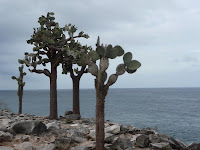Thats more or less what most of the Galapagos islands look like!
For the most part they are some of the bleakest, harshest, most Arid, little god-forsaken chunks of land on the planet !
Its quite surreal walking around in the baking heat on little islands made of nothing but lava and covered with the deadest, driest looking, miserable little sticks and cactus that youve ever seen!





The plants are however, not dead at all, they are just dormant for the dry season... They are perfectly adapted to this incredibly harsh environment... just like the animals that we all know at least a little of.
Its what makes the Galapagos special... Their climate... Or more accurately; Their climates (plural).
The islands are the product of a volcanic hotspot located on the boundary of two separating tectonic plates. There are about a dozen decent sized islands ( and a few dozen more tiny ones and rocky outcrops) and they are all either directly created by volcanic eruptions or (for one or two) by tectonic uplift of lava flows that were below the ocean surface. Thats not so special in its self, but they are located hundreds of nautical miles from any other land; And they are also located at the confluence of four different Pacific ocean currents....
And thats what "does the trick" so to speak...
The combination of isolation, mixing warm and cold ocean currents (resulting in very rich marine life), equatorial location, volcanoes of different altitudes, and isolation from all other land has made them into "natures own environmental experimental pallet". The climate on each island, and on each part of the larger islands is different... But its not just "different", Its different, AND incredibly Harsh ... But not so harsh that Nature abandons it all together !
Given time Nature finds a way... And the ways are beautiful and unexpected :)) ... And if we havent come to expect just that kind of outcome from Nature yet, then we just have not been paying attention! :))))
And, the isolation too, is not complete, its only "almost". And over the millennia, the odd "castaway" plant or animal has made landfall on these barren little islands and has found a foothold. And undoubtedly, most of them died pretty quickly and unpleasantly... But, occasionally something managed to survive, and even reproduce... And most importantly (as far as evolution is concerned) to ADAPT and pass those adaptations on to their offspring...
And thats what makes the Galapagos special as far as we humans are concerned... They inspired Charles Darwin to put forward his theory of Evolution.. And that has changed the way we humans see everything.
Ive read a bit (in the past, though not recently) about the studies done on the Galapagos plants and animals and a bit on Darwin too, but I never "studied" biological sciences after early secondary school, so there is without doubt lots that I dont know.
As I recall though, it was the multitude of adaptations of the beaks (I think there are about a dozen different species of them) of the little finches on the island that Darwin chose as a strong exemplar of his theory of evolution. So, while I was visiting the islands, I kept an eye out for these little birds, and sure enough, they were pretty much all over the place.. Little black or grey/brown birds with beaks of different shapes and sizes. And they flitted around here and there, and if you look you see them.
But, you know what, Its far from obvious that these little birds are so different from island to island or a bit surprising to the casual observer that they, above all the other creatures and plants on the islands, were so significant...
What that highlights to me is the incredible scrutiny that Darwin applied to the world as he moved through it... He didnt just look at stuff; He LOOKED at it ... ALL of it... And he thought HARD about it ALL!! ... The power of observation and critical thought... Truly Brilliant!
If we all could but emulate this...
And sure enough, biological scientists are still happily studying the life of the Galapagos islands to this day... And they are learning more about how evolution really does work on a year by year basis here, as the micro-climates of the islands changes with El Nino and global warming, and the plants and animals continue to adapt.. and species start to emerge while others seem to combine and dissolve.
Quite literally, the iguanas and boobies are apparently producing new varieties that are diverging year by year from their forebears.
And as the plants on an island adapt to changing climates and their seed sizes change (no longer diverging into two different sizes), so too, the finches of that island that were diverging into two different beaks for the different seeds are now reverting back to the single variety that lived on the island before them.
Its all very dynamic... and perfectly balanced... The way Nature always does it :)))